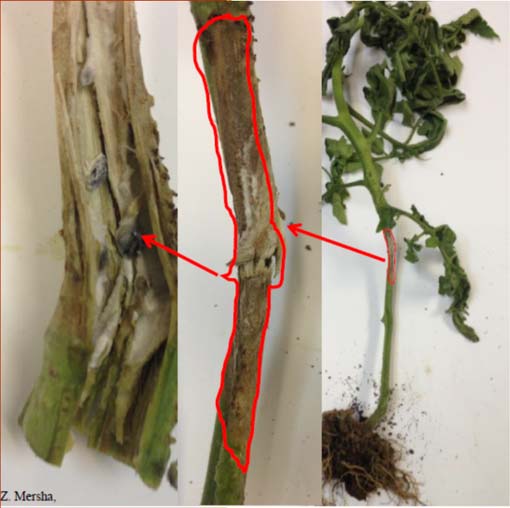Taking an environmentally sensitive approach to pest management
Timber Rot on Tomato
Published: August 1, 2015
Timber rot is a sporadic but also devastating disease of tomato that can cause significant plant and yield loss if cool weather and high humidity prevail for a longer duration. The increasing number of greenhouses and high tunnels that grow tomatoes year-afteryear has made the disease much more prevalent today, compared to decades ago.
Timber rot (sometime called “white mold”) is a stem rot disease that is caused by the fungus Sclerotinia sclerotiorum. The latter has a wide host range of over 300 crops and frequently vegetables such as beans, cabbage, lettuce, sunflower, carrots, cucumbers, peas, pumpkins and squash. A number of common weeds such as lambsquarters, pigweed, Canada thistle, and wild mustard also are susceptible and can serve as a source of infection.
Symptoms of timber rot mostly begin as water-soaked areas from the stem axils or instem joints, either at or above the soil level. The fungus enters from at the soil level if senescent tissue is present Once established, the disease progresses from these areas. In time, the stem becomes covered with white “cotton-like” fluffy mycelium and girdled; later, the watersoaked area becomes dry, discolored (bleached appearance) and hard; and the plant (eventually) wilts, collapses, and dies.
As the disease progresses, hard, grayish-black sclerotia about the size of a plump grain of rice develop. Sclerotia are hardened masses of mycelium containing food reserves. Their role in the life cycle of the disease organism is to detach from the host and remain dormant (in the soil) until environmental conditions favorable for infection occur.
Slicing the diseased stem longitudinally reveals these embedded structures, making positive identification fairly easy.

Typical symptoms and signs of timber rot disease on tomato plant (right), and closeup pictures of the infected stem showing mycelia (middle) and sclerotia (right). Photo by Z. Mersha.
Timber rot infection usually does not occur until after flowering has begun. At this time soil moisture usually is high and soil temperature low because of the shading provided by leaves. Under this combination of cool, moist conditions, the abovementioned sclerotia produce mycelium that infect the stem of the plant.
These sclerotia also produce sexual spores called ascospores from structures called apothecia (cup or little mushroom like structures). Ascospores of timber rot are windborne and can cause infection within several days after landing on the leaf of a plant. Again, cool (e.g. 60-70o F), moist conditions favor infection.
Timber rot in greenhouses and high tunnels that produce tomatoes year-after-year is problematic because of the buildup of sclerotia in the soil from diseased plants of previous crops. Crop rotation along with less favorable environmental conditions makes timber rot on outdoor tomato plantings much less of a problem. Control of timber rot should follow an IPM approach. First, rotating tomatoes with non-susceptible crops can reduce disease inoculum. Unfortunately, this is not an option for most greenhouse or high tunnel tomato growers. Even then, the fact that this fungus attacks a broad range or crops makes the smart rotation option very difficult. For field plantings, however, rotating grasses like corn or small grain will help slow down the inoculum buildup.
Deep plowing (e.g. at least 12 inches) can help to reduce disease severity by reducing the number of sclerotia at the surface of the soil. However, disturbing the soil through tillage will reduce the effectiveness of this practice by bringing the sclerotia back up to the surface.
Strict sanitation is helpful in managing the disease. This includes carefully removing and destroying diseased tissues and plants, thereby reducing the number of sclerotia allowed to remain in the soil to infect next year’s planting. Also, maintaining a “plant free zone” around the perimeter of the greenhouse is recommended. This practice will make it more difficult for ascospores from infected host species surrounding the greenhouse to enter. Additionally, it helps control insect entry into the greenhouse.
Pyraclostrobin (Cabrio®) and fluxapyroxad + pyraclostrobin (Priaxor®) are two materials labeled for the suppression of timber rot on tomato for field plantings only. Both are labeled use on a number of crops for the control of a wide variety of fungal diseases.
For greenhouses that already have an established history of timber rot, the beneficial fungus Coniothyrium minitans sold under the brand name of Contans® holds a promise. This biocontrol agent colonizes the soil of a greenhouse and feeds on timber rot sclerotia in the process. According to label directions, Contans ® should be applied at least three months prior to planting to allow the fungal organism to destroy sclerotia in the soil. Since Contans® is a living organism, proper storage conditions, handling, and proper timing of its application are needed to maintain its effectiveness. For any further information as to the rate and frequency of applications, growers are highly encouraged to read and follow the label of this product.
Currently, there are no varieties of tomato known to be resistant to timber rot.
Editor’s notes:
- A high tunnel is considered a field planting if fully open for the reentry interval (REI).
- For high tunnel or greenhouses with a history of this disease it may be best to limit cover crops to grasses, such as oats, ryegrass, etc.
- Manure from cattle or horses can contain the sclerotia, and composting may not destroy them. Poultry litter and compost from it should pose minimal risk for having sclerotia.
Subscribe to receive similar articles sent directly to your inbox!
REVISED: November 16, 2015